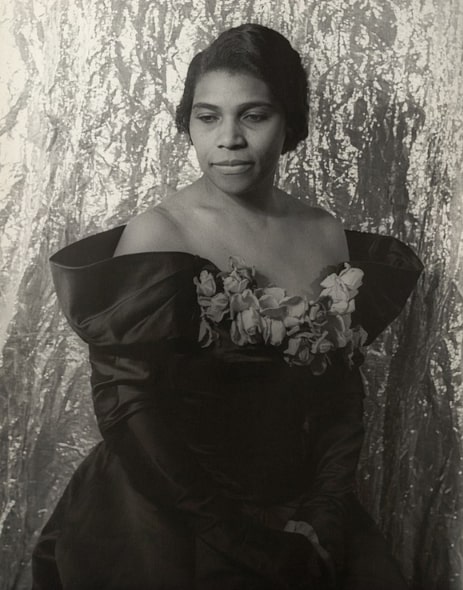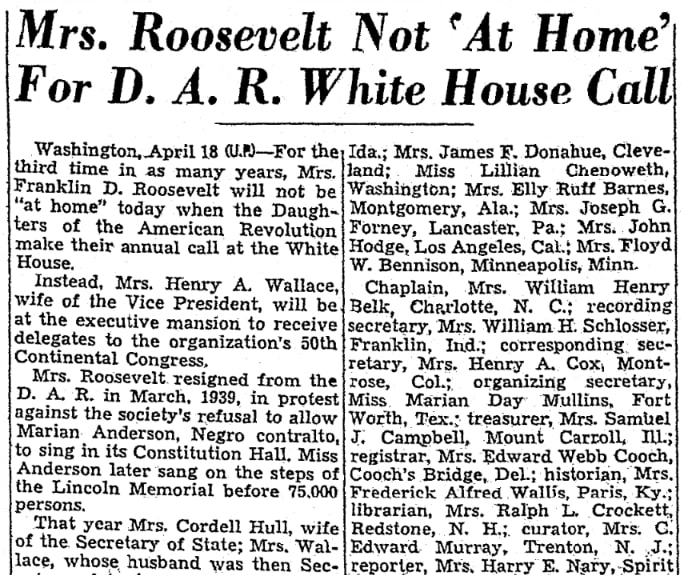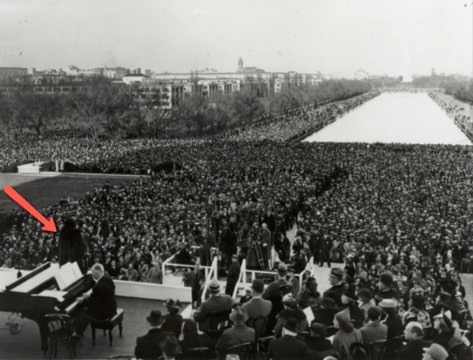Introduction: In this article, Jane Hampton Cook writes a follow-up to her earlier story about a 1939 Easter concert when Black contralto Marian Anderson sang to an integrated audience of 75,000 from the steps of the Lincoln Memorial. Jane is a presidential historian and author of My Country ’Tis of Thee for children. Her works can be found at Janecook.com. She is also the host of Red, White, Blue and You
First Lady Eleanor Roosevelt launched a controversy in 1939 when she revealed in her nation-wide weekly newspaper column that she was resigning from an unnamed organization – one that the press and public knew was the Daughters of the American Revolution (DAR) – because they’d declined to let Marian Anderson, an internationally acclaimed black American singer, perform in DAR’s Constitution Hall for an Easter concert.

From the DAR’s official website:
Their [promoters for Marian Anderson] request for a concert on April 9 [1939, in DAR Constitution Hall] was denied, reportedly due to a previous booking on the same date by the National Symphony Orchestra. While it was true that there was another booking on April 9, the management also gave another reason for Marian Anderson’s rejection. Namely, there was a policy in place at Constitution Hall at that time which allowed only white artists to perform in the auditorium.
Instead, Anderson sang on the steps of the Lincoln Memorial, which attracted 75,000 attendees (see: Marian Anderson Sings Her Way into History, Easter 1939). But that’s not the end of the story.
The press hits against the DAR continued for nearly four years. The Reading Eagle reported on 18 April 1941:
For the third time in as many years, Mrs. Franklin D. Roosevelt will not be “at home” today when the Daughters of the American Revolution make their annual call at the White House.

Similarly, when the Department of the Interior launched an art contest for a mural of Anderson’s Lincoln Memorial concert at the department’s headquarters, the press resurrected the controversy again.
However, the DAR relented and in September 1942 invited Anderson to perform in Constitution Hall.
This article reports:
Ten days later [after First Lady Eleanor Roosevelt resigned from the DAR] the DAR president, then Mrs. Henry M. Robert Jr., said the ban against use of the hall by colored artists had been adopted in 1927 because “experience showed the Society could not go contrary to or further than the customs existing in the city in which its properties were located.”
Marian Anderson accepted the DAR’s 1942 invitation and sang in Constitution Hall on 7 January 1943 – and newspapers reported this breakthrough.
The concert was one of several benefiting war charities that winter. Both Anderson and the DAR donated their services. Miss Anderson’s concert at DAR’s Constitution Hall benefited the United China Relief Fund. At the time during World War II, the United States and China were allies against Japan. One of Anderson’s stipulations for the concert was to bar segregating the audience. The DAR agreed. The integrated concert was sold out.
What changed? For one thing, the leadership of the DAR changed, according to its standard calendar. Public awareness of racial issues was slowly changing also.
A new president leading the DAR began making amends starting in 1941, when a black male quartet performed at Constitution Hall as part of President Franklin Roosevelt’s third inauguration festivities.
The DAR took a more proactive position in 1942 when it invited Marian Anderson to perform in the first of several World War II benefit concerts.
Washington D.C.’s Evening Star reported that Interior Secretary Ickes praised both the DAR and Anderson.
This article reports:
Secretary Ickes also paid tribute to the Daughters of the American Revolution for “offering the platform to Miss Anderson while saying to her people that they will be welcomed on the same basis as others.” Tonight Miss Anderson makes her first concert appearance in Constitution Hall for the benefit of the China Relief Fund, with every ticket sold out in advance.
Referring to the DAR’s present stand, as compared with its refusal four years ago to permit the colored soprano to sing in Constitution Hall, Secretary Ickes told an audience of 900 white and colored men and women at Interior Department auditorium last night that “it takes more strength of character to admit a change of conviction than to adhere tenaciously to it.”
This article further reports that Anderson, who chose “My Country ’Tis of Thee” for her first number, reflected that for her Lincoln Memorial concert she was:
“Deeply touched by the fact that I can be in any way a symbol of democracy. That Easter Sunday concert was more than a concert for me. It was a dedication. When I stood on the steps of the Lincoln Memorial with the statue of President Lincoln at my back and 75,000 fellow countrymen before me, it seems that everyone present was a living witness to the ideals of freedom for which President Lincoln died. When I sang that day I was singing to the entire nation.”
In all, Marian Anderson ended up performing in Constitution Hall five times, from 1943 to 24 October 1964 – when she began her farewell American tour with a performance in the DAR concert hall.
We’ll give the last word to the Daughters of the American Revolution. From their website:
The National Society Daughters of the American Revolution deeply regrets that it did not give Marian Anderson the opportunity to perform her 1939 Easter concert in Constitution Hall, but today we join all Americans in grateful recognition that her historic performance on the steps of the Lincoln Memorial was a pivotal point in the struggle for racial equality.
Ms. Anderson’s legendary concert will always be remembered as a milestone in the Civil Rights movement. The beauty of her voice, amplified by her courage and grace, brought attention to the eloquence of the many voices urging our nation to overcome prejudice and intolerance. It sparked change not just in the DAR but in all of America.
Our organization truly wishes that history could be re-written, but knowing that it cannot, we are proud to note that Dar has learned from the past.
Explore over 330 years of newspapers and historical records in GenealogyBank. Discover your family story! Start a 7-Day Free Trial
Note on the header image: American contralto Marian Anderson performing on the steps of the Lincoln Memorial in front of 75,000 spectators on 9 April 1939, Easter Sunday. Finnish accompanist Kosti Vehanen is on the piano. Credit: U.S. Information Agency; Wikimedia Commons.
Related Article:
